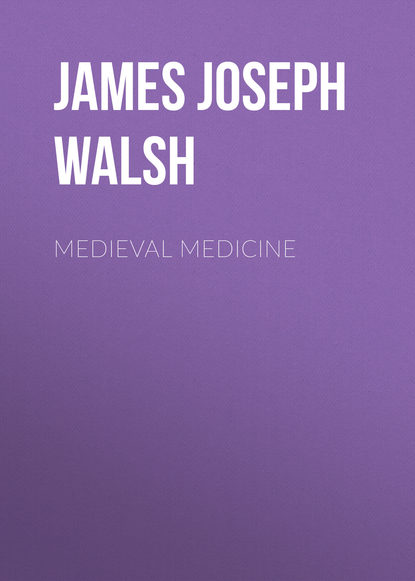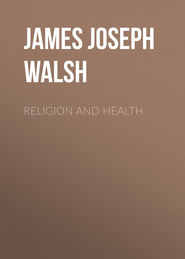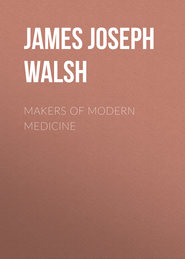По всем вопросам обращайтесь на: info@litportal.ru
(©) 2003-2024.
✖
Medieval Medicine
Настройки чтения
Размер шрифта
Высота строк
Поля
Some of the general principles of medical practice which Alexander lays down are very significant even from our modern standpoint. He deprecated drastic remedies of all kinds. He did not believe in severe purgation nor in profuse or sudden blood-letting. His diagnosis was thorough and careful. He insisted particularly on inspection and palpation of the whole body; on careful examination of the urine, of the fæces, and the sputum; on study of the pulse and the breathing. He dwelt on the fact that much might be learned from the patient’s history taken carefully. The general constitution was the most important element, in his estimation. His therapeutics is, above all, individual. Remedies must be administered with careful reference to the constitution, the age, the sex, and the condition of the patient’s strength. Special attention must always be paid to seconding nature’s efforts to cure. Alexander had no sympathy at all with the idea that nature was to be disturbed, much less that remedies must work in opposition to natural tendencies to recovery.
Paul of Ægina, educated at the University at Alexandria, probably flourished during the reign of the Emperor Heraclius, who died 641; his works contain more of surgical than of medical interest.
The Arab writer, Abul Farag, to whose references we owe the definite placing of the time when Paul lived, said that “he had special experience in women’s diseases, and had devoted himself to them with great industry and success. The midwives of the time were accustomed to go to him and ask his counsel with regard to accidents that happen during and after parturition. He willingly imparted his information, and told them what they should do. For this reason he came to be known as the Obstetrician.” Perhaps the term should be translated the man-midwife, for it was rather unusual for men to have much knowledge of this subject. His knowledge of the phenomena of menstruation was wide and definite. He knew a great deal of how to treat its disturbances. He seems to have been the first one to suggest that in metrorrhagia, with severe hæmorrhage from the uterus, the bleeding might be stopped by putting ligatures around the limbs. This same method has been suggested for severe hæmorrhage from the lungs as well as from the uterus in our own time. In hysteria he also suggested ligature of the limbs, and it is easy to understand that this might be a very strongly suggestive treatment for the severer forms of hysteria. It is possible, too, that the modification of the circulation to the nervous system induced by the shutting off of the circulation in large areas of the body might very well have a favourable physical effect in this affection. Paul’s description of the use of the speculum is as complete as that in any modern textbook of gynæcology.
In the chapter on the medieval care of the insane, there are some clinical observations and suggestions as to treatment from Paul which make it very clear what a careful observer he was, and how rational in his application of such knowledge as he had to the treatment of patients. Probably his contributions to the difficult subject psychiatry, well above a thousand years ago, will serve to make his genius as a physician clearer than almost anything else that could be said of him.
Among the great Arabian physicians who represent the transition period, from the earlier Middle Ages directly under Greek influence, still surviving to the later Middle Ages, when the earlier Renaissance brought back the Greek masters once more, were Rhazes, Ali Abbas, Avicenna—whose name had been transformed from the Arabic Ibn Sina—Abulcasis, Avenzoar, and Averroes, the last named a philosophic theorist but not a physician. The first three named were born in the East, the last three in Spain. Besides these Maimonides, the great Jewish physician, who was born and educated at Cordova in Spain, deserves a place. In this earlier period Rhazes must be mentioned, while the others who merit special attention will be considered in the chapter on Later Medieval Medicine.
Rhazes (died 932) is one of the great epoch-makers in the history of medicine. He was the first to give us a clear description of smallpox. Some of his medical aphorisms are well worth noting, and make it very clear that he was a careful observer.
“When you can heal by diet, prescribe no other remedy; and where simple remedies suffice, do not take complicated ones.”
Rhazes knew well the value of the influence of mind over body even in serious organic disease, and even though death seemed impending. One of his aphorisms is: “Physicians ought to console their patients even if the signs of impending death seem to be present.” He considered the most valuable thing for the physician to do was to increase the patient’s natural vitality. Hence his advice: “In treating a patient, let your first thought be to strengthen his natural vitality. If you strengthen that, you remove ever so many ills without more ado. If you weaken it, however, by the remedies that you use, you always work harm.” The simpler the means by which the patient’s cure can be brought about, the better in his opinion. He insists again and again on diet rather than artificial remedies. “It is good for the physician that he should be able to cure disease by means of diet, if possible, rather than by means of medicine.” Another of his aphorisms seems worth while quoting: “The patient who consults a great many physicians is likely to have a very confused state of mind.”
During the ninth and tenth centuries the Arabs continued to be the most important contributors to medicine, until the rise of the school at Salerno gave a new impetus to clinical observation, and furnished a new focus of medical attention in the West. Constantine brought whatever of Arab influence there was in Salerno, as we have pointed out in the chapter on the Beginnings of Medical Education; but after his time there is an originality about Salernitan medicine which makes it of great value as the foster-mother of the sciences related to medicine during the later Middle Ages.
CHAPTER III
SALERNO AND THE BEGINNINGS OF MODERN MEDICAL EDUCATION
The first medical school of modern history, and the institution which more than any other has helped us to understand the Middle Ages, is that of Salerno. Indeed, the accumulation of information with regard to this medical school, formally organized in the tenth century but founded a century earlier, and reaching a magnificent climax of development at the end of the twelfth century, has done more than anything else to revolutionize our ideas with regard to medieval education and the scientific interests of the Middle Ages. We owe this development of knowledge to De Renzi, whose researches with regard to matters Salernitan, and medical education generally in Italy in the Middle Ages, are well deserving of the prestige that has been at length accorded them.
In his “Storia della Medicina in Italia,” published so modestly at Naples, the patient Italian student of medical history made an epoch-making contribution to the history of medicine. Unless one has actually read his book, it is difficult to understand how deep our obligations to him are. Anyone who might be tempted to think that medicine was not taken seriously, or that careful clinical observations and serious experiments for the cure of disease were not made at Salerno, will be amply undeceived by a reading of De Renzi. Above all, he makes it very clear that medical education was taken up with rigorous attention to details and high standards maintained. Three years of college work were demanded in preparation for medical studies, and then four years at medicine, followed by a year of practice with a physician, and even an additional year of special study in anatomy, had to be taken, if surgery were to be practised. All this before the licence to practise medicine was given; though the degree of doctor, granting the privilege of teaching as the word indicates, was conferred apparently after the completion of the four years at the medical school. We have had to climb back to these medieval standards of medical education in many countries in recent years, after a period of deterioration in which often the requirements for the physician’s training for practice were ever so much lower.
It may seem surprising that the first medical school should have arisen in the southern part of Italy, but for those who know the historical conditions it will seem the most natural thing in the world that this development should have come in this region. As we have said, touch with Greek has always been the most important factor for modern educational and intellectual development. Salerno was situated in the heart of that Greek colony in the southern part of Italy which came to be known as Magna Græcia. Apparently at no time during the Middle Ages was Greek entirely a dead language in this part of Italy, and there were Greek travellers, Greek sailors, and many other wanderers, who made their way along the shores of the Mediterranean at this time, and carried with them everywhere the stimulus that always came from association with the Greeks of Asia Minor and of the Grecian Islands and peninsula.
There were two other factors that made for the development of the medical school at Salerno. The first of these seems undoubtedly to have been the presence of the Benedictines, who had a rather important school at Salerno, and who were closely in touch with their great mother-house at Monte Cassino not far away. It was they who imparted the academic atmosphere to the town, and made it possible to gather together the elements for the university which gradually came into existence around the medical school, after that began to attract European attention.
The actual foundation of the medical school, however, seems to have been due to the fortunate accident that Salerno became a health resort, a place to which invalids were attracted from many parts of Europe because the climate was salubrious, and opportunities for obtaining the medical advice of men of many different schools of thought from all over the Mediterranean, and securing the Oriental drugs which were so much valued—as drugs from a distance always are—were there afforded. It is easy to understand that, especially in the winter-time, better-class patients from all over Europe would be glad to go down to the mild temperate climate of Salerno and spend their time there.
It has been pointed out that the first modern university, that of Salerno, had for a nucleus a medical school, representing man’s interest in his body as his primary intellectual purpose in modern history. The second modern university, that of Bologna, gathered around a law school representing man’s interest in his property—his second formal purpose in life. And the third, that of Paris, developed around a school of theology and philosophy, demonstrating that man’s intellectual interests rise finally to the consideration of his relations to his fellow-man and to God.
The first that we know definitely about the medical school of Salerno, the origin of which is difficult to trace, is concerned with Alphanus, usually designated “the First,” because there are several of the name. He was a Benedictine monk, distinguished as a literary man and known by his contemporaries as both poet and physician, who was afterwards raised to the Bishopric of Salerno. He had taught at Salerno in the Benedictine school there before becoming Bishop, and when exercising the highest ecclesiastical authority did much to encourage the development of Salerno. He states that medicine flourished in the town even in the ninth century, and there is an old chronicle published by De Renzi in his “Collectio Salernitana” in which it is said that the medical school was founded by four doctors—a Jewish Rabbi, Elinus; a Greek, Pontus; a Saracen, Adale; and the fourth a native of Salerno—each of whom lectured in his native language. This reads like a mythical legend that has formed around some real tradition of the coming of physicians from many countries. Puschmann in his “History of Medical Education” has suggested that the names are probably as much varied as the absolute truth of the facts. Elinus, the Jew, is probably Elias or Eliseus, Adale is probably a corruption of Abdallah, and Pontus should be probably Gariopontus.
There was a hospital at Salerno that was somewhat famous as early as the first quarter of the ninth century. This was placed under the control of the Benedictines; and other infirmaries and charitable institutions, similarly under the care of religious orders, sprang up in Salerno to accommodate the patients that came. The practical character of the teaching at Salerno, as preserved for us in the writings of the school, would seem to argue that probably those who came to study medicine here were brought directly in contact with the patients, though we have no definite evidence of that fact.
The most interesting feature of the medical school at Salerno is undoubtedly the development of legal standards of medical education in connection with the school. Before the middle of the twelfth century Roger, King of the Two Sicilies, issued a decree according to which preliminary studies at the University were required as a preparation for the medical school, and four years of medical studies were made the minimum requirement for the degree of doctor in medicine, which was, however, as we have said, not a licence to practise, but only a certificate authorizing teaching. There seemed to have been, even thus early, some further state regulations with regard to practice. About the middle of the next century, however, there came, through a law of the Emperor Frederick II., a still further evolution of legal standards for medical education and medical practice in the Two Sicilies. This law required that the student of medicine should have spent some years, probably the equivalent of our undergraduate training, in the university before studying medicine, and that he should then devote four years to medicine, after which, on proper examination, he might be given the degree of doctor—that is, teacher of medicine; but he must spend a further year of practice with a physician before he would be allowed to practise for himself.
This is such a high standard that, only that we have the actual wording of the law, it would seem almost impossible that it could have been evolved at this period in medical history. It actually represents the standard that we have climbed back to generally only during the past generation or two, and in the interval there have been many rather serious derogations from it. This law of the Emperor Frederick is, moreover, a pure drug law, regulating the sale of drugs and their purity, and inflicting condign punishment for substitution; in this regard also anticipating our most recent well-considered legislation. The penalty by which the druggist was fined all his movable goods for substitution, while the government inspector who permitted such substitution was put to death, would seem to us in the modern time to make the punishment eminently fit the crime. Almost needless to say, then, the law (see Appendix for full text) represents one of the most important documents in the history of medicine, particularly of medical education. The fee regulation included in it shows that medicine was looked upon as a profession, and was paid accordingly.
From Salerno come many of the traditions of the conferring of degrees which are still used in a large number of modern medical schools. Before receiving his degree, the candidate had to take an oath, of which the following were the principal tenets: “Not to contradict the teaching of his college, not to teach what was false or lying, and not to receive fees from the poor even though they were offered; to commend the sacrament of penance to his patients, to make no dishonest agreement with the druggists, to administer no abortifacient drug to the pregnant, and to prescribe no medicament that was poisonous to human bodies.”
It has sometimes been said that youths of tender age were admitted to the study of medicine at Salerno, and that many of them were given their degrees at the age of twenty-one. De Renzi’s discussion would seem to show that the usual age of receiving the degree was twenty-five to twenty-seven. As medical students had to have three years of preparatory studies in literature and philosophy, it would seem that they must have been rather mature on their admission to the medical schools.
De Renzi tells us that the medical school of Salerno was of great importance not only for medical education, but it acquired sufficient means to extend its benefits over the entire city. Gifts were made of statues to the churches, and especially to the shrine of St. Matthew the Apostle, situated here; monuments were set up, inscriptions placed and ample donations made to the various institutions of the city. The formal name of the medical school was Almum et Hippocraticum Medicorum Collegium. This is the first use that I know of the word almum in connection with a college, and may very well be the distant source of our term alma mater. The medical school was situated in the midst of an elevated valley which opened up on the mountain that dominates Salerno, and while enjoying very pure air must have been scarcely disturbed at all by the winds which can be blustery enough from the gulf. De Renzi says that in his time some of the remains could still be seen, though visitors to Salerno now come away very much disappointed because nothing of interest is left.
The most famous of the teachers at Salerno was Constantine Africanus, so called because he was born near Carthage. His life runs from the early part of the eleventh century to near its close, and he lived probably well beyond eighty years of age. Having studied medicine in his native town, he wandered through the East, became familiar with a number of Oriental languages, and studied the Arabian literature of science, and above all of medicine, very diligently. The Arabs, owing to their intimate contact with the Greeks in Asia Minor, had the Greek authors constantly before them, and Hippocrates and Galen have always roused men to do good work in medicine. Constantine seems not to have learned Greek, finding enough to satisfy him in the Arabic commentaries on the Greek authors, and probably confident, as all young men have ever been, that what his own time was doing must represent an advance over the Greek. He brought back with him Arabian books and a thorough knowledge of Arabian medicine. When he settled down in Carthage he was accused of magical practices, his medical colleagues being apparently jealous of his success—at least, there is a tradition to that effect to account for his removal to Salerno, though the immediate reason seems to have been that his reputation attracted the attention of Duke Robert of Salerno, who invited him to become his physician.
After Constantine’s time the principal textbooks of the school became, according to De Renzi, Hippocrates, Galen, and Avicenna. To these were added the Antidotarium of Mesue, and there were various compendiums of medical knowledge, quite as in our own time—one well known under the name of Articella. In surgery the principal textbook was the surgical works of the Four Masters of Salerno, which interestingly enough was the sort of combination work gathered from a series of masters that we are accustomed to see so frequently at the present day. De Renzi insists that there was much less Arabic influence at Salerno than is usually thought; and Gurlt more recently has emphasized, as we have said, the fact that the great textbooks of surgery which we have from Salerno contain not Arabisms, as might be expected from the traditions of Arabic influence that we hear so much of, but Græcisms, which show that here at Salerno there was a very early Renaissance, and the influence of Greek writers was felt even in the twelfth century.
Probably the best way to convey in brief form a good idea of the teaching in medicine at Salerno is to quote the Regimen Sanitatis Salernitanum, the Code of Health of the School of Salernum, which for many centuries was popular in Europe, and was issued in many editions even after the invention of printing. Professor Ordronaux, Professor of Medical Jurisprudence in the law school of Columbia College (now Columbia University, New York), issued a translation of it in verse,[3 - Philadelphia: Lippincott, 1871.] which gives a very good notion of the contents and the spirit and the mode of expression of the little volume.
The Regimen was written in the rhymed verses which were so familiar at this time. Many writers on the history of medicine have marvelled at this use of verse, but anyone who knows how many verse-makers there were in the twelfth and thirteenth centuries all over Europe will not be surprised. It used to be the custom to make little of these rhymed Latin verses of the Middle Ages, but it may be well to recall that in recent years a great change has come over the appreciation of the world of literature in their regard. The rhymed Latin hymns of the Church, especially the Dies Iræ, the Stabat Mater, and others, are now looked upon as representing some of the greatest poetry that ever was written. Professor Saintsbury of the University of Edinburgh has declared them the most wondrous wedding of sense and sound that the world has ever known. The Regimen Sanitatis of Salerno is of course no such poetry, mainly because its subject was commonplace and it could not rise to poetic heights. A good deal of the deprecation of its Latinity might well be spared, for most of the mistakes are undoubtedly due to copyists and interpolation. The verses not only rhyme at the end, but often there are internal sub-rhymes. This too was a very common custom among the hymn-writers, as the great sequence of Bernard of Morlaix, so well known through its translations in our time, as “Jerusalem the Golden” attests.
The Regimen was not written for physicians, but for popular information. It seems to have been a compilation of maxims of health from various professors of the Salernitan School. Nothing that I know shows more clearly the genuine knowledge of medicine, and the careful following of the first rule of medical practice non nocere to which Salerno had reached at this time, than the fact that this popular volume contained no recommendation of specific remedies, but only health rules for diet, air, exercise, and the like, many of which are as valuable in our time as they were in that, and very few of which have been entirely superseded—together with some general information as to simples, and a few details of medical knowledge that would give a convincing air to the compilation.
The book was dedicated to the King of the English, Anglorum regi scribit schola tota Salerni, and in the translation made by Professor Ordonaux begins as follows:
If thou to health and vigour wouldst attain,
Shun weighty cares—all anger deem profane,
From heavy suppers and much wine abstain.
Nor trivial count it, after pompous fare,
To rise from table and to take the air.
Shun idle, noonday slumber, nor delay
The urgent calls of Nature to obey.
These rules if thou wilt follow to the end,
Thy life to greater length thou mayst extend.[4 - The Latin lines run thus:]
Evidently it was rather easy to commit such rhymes to memory, and this accounts for the fact that we have many different versions of the Regimen and disputed readings of all kinds. These medieval hygienists believed very much in early rising, cold water, thorough cleansing, exercise in the open air, yet without sudden cooling afterwards. The lines on morning hygiene seem worth while giving in Ordonaux’s translation.
At early dawn, when first from bed you rise,
Wash, in cold water, both your hands and eyes.
With brush and comb then cleanse your teeth and hair,
And thus refreshed, your limbs outstretch with care.
Such things restore the weary, o’ertasked brain;
And to all parts ensure a wholesome gain.
Fresh from the bath, get warm. Rest after food,
Or walk, as seems most suited to your mood.
But in whate’er engaged, or sport, or feat,
Cool not too soon the body when in heat.
The Salernitan writers were not believers in noonday sleep, though one might have expected that the tradition of the siesta in Italy had been already established. They insist that it makes one feel worse rather than better to break the day by a sleep at noonday.
Let noontide sleep be brief, or none at all;
Else stupor, headache, fever, rheums, will fall
On him who yields to noontide’s drowsy call.
They believed in light suppers—
Great suppers will the stomach’s peace impair;
Wouldst lightly rest, curtail thine evening fare.
With regard to the interval between meals, the Salernitan rule was, wait until your stomach is surely empty:
Eat not again till thou dost certain feel
Thy stomach freed of all its previous meal.
This mayst thou know from hunger’s teasing call,











